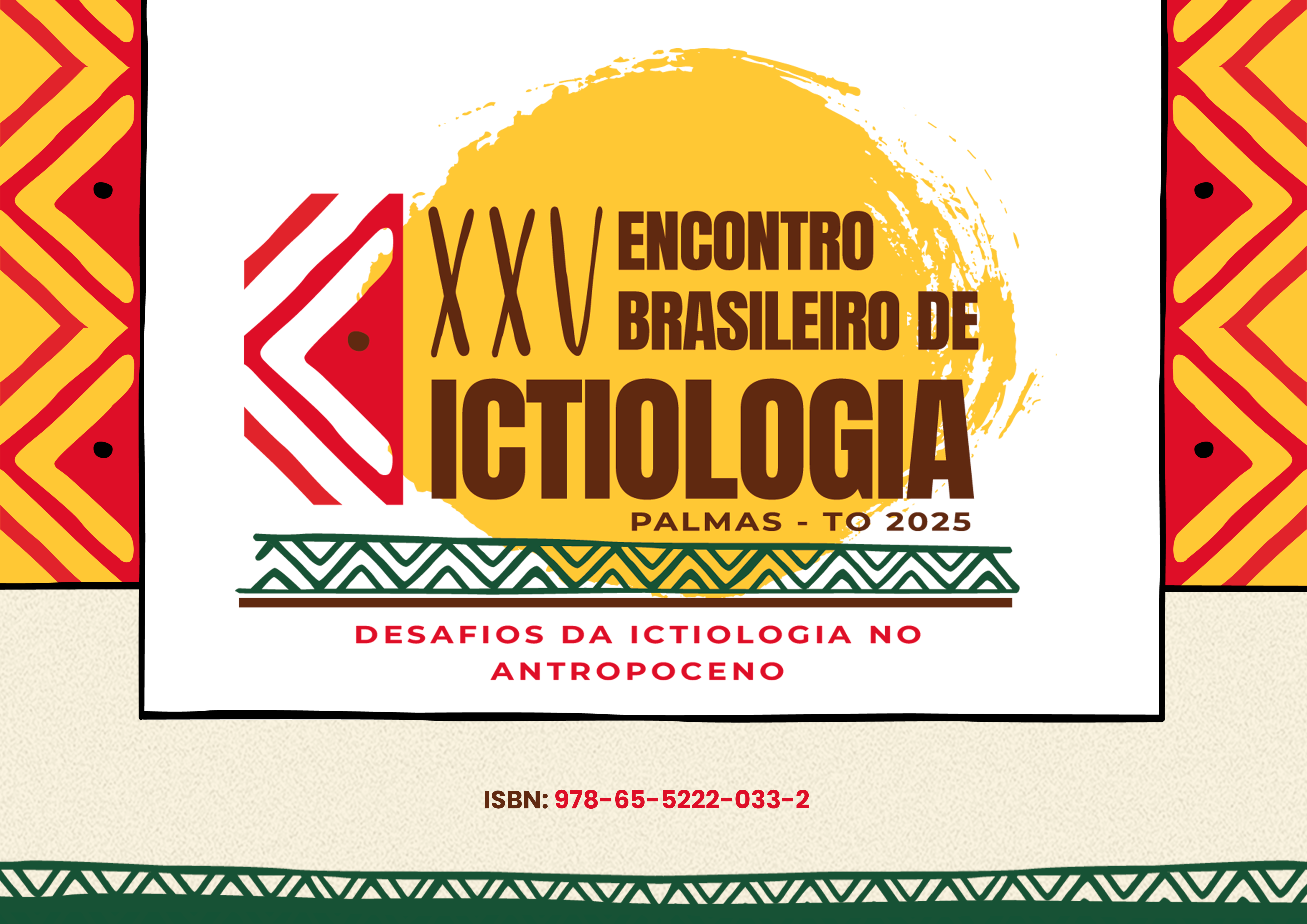DNA BARCODE ANALYSIS REVEALS A NEW SPECIES OF STEINDACHNERIDION FROM THE PARANÁ RIVER BASIN (SILURIFORMES, PIMELODIDAE)
"2025-02-12 10:36:07" // app/Providers/../Base/Publico/Artigo/resources/show_includes/info_artigo.blade.php
App\Base\Administrativo\Model\Artigo {#1845 // app/Providers/../Base/Publico/Artigo/resources/show_includes/info_artigo.blade.php #connection: "mysql" +table: "artigo" #primaryKey: "id" #keyType: "int" +incrementing: true #with: [] #withCount: [] +preventsLazyLoading: false #perPage: 15 +exists: true +wasRecentlyCreated: false #escapeWhenCastingToString: false #attributes: array:35 [ "id" => 119917 "edicao_id" => 384 "trabalho_id" => 412 "inscrito_id" => 55 "titulo" => "DNA BARCODE ANALYSIS REVEALS A NEW SPECIES OF STEINDACHNERIDION FROM THE PARANÁ RIVER BASIN (SILURIFORMES, PIMELODIDAE)" "resumo" => "Steindachneridion is a genus of six species distributed in the Atlantic Forest's isolated drainages. Steindachneridion amblyurum, the type species of the genus, has been described from the Jequitinhonha River basin, S. doceanum from the Doce River basin, and S. parahybae from the Paraíba do Sul River basin. In the Paraná River basin, S. scriptum, S. punctatum, and S. melanodermatum have been described. DNA barcode analyses with the cytochrome oxidase subunit I gene, using different methods of species delimitation (genetic distance, mPTP, and ASAP), corroborate the discrimination of the species S. amblyurum, S. doceanum and S. parahybae. Steindachneridion scriptum and S. melanodermatum were joined by that analysis. Still, GMYC indicates the validity of S. melanodermatum and two lineages in S. scriptum, one for the Uruguay River basin (type locality of the species) and another for the upper Paraná River and Iguaçu River basin downstream of the falls. In this analysis, S. amblyurum is recovered as the sister to the other species, S. doceanum, the sister of S. parahybae, and this clade as the sister of S. scriptum (Uruguay), S. melanodermatum (Iguaçu), and S. scriptum (Upper Paraná + lower Iguaçu River). Considering the geographic isolation of those three lineages of the Paraná River basin, we consider the delimitation obtained with GMYC to be the most representative of Steindachneridion evolution. Thus, a new species of Steindachneridion from the Paraná River was revealed using the DNA barcode. The species S. punctatum was not corroborated by the analysis due to the lack of tissue samples related to its rarity in the environment." "modalidade" => "Pôster (PO)" "area_tematica" => "AT 02 - Taxonomia e Sistemática" "palavra_chave" => ", , , , " "idioma" => "Português" "arquivo" => "TRABALHO__EV205_MD4_ID55_TB412_07102024110843.pdf" "created_at" => "2025-02-13 11:08:16" "updated_at" => null "ativo" => 1 "autor_nome" => "OSCAR AKIO SHIBATTA" "autor_nome_curto" => "OSCAR" "autor_email" => "shibatta@uel.br" "autor_ies" => "UNIVERSIDADE ESTADUAL DE LONDRINA (UEL)" "autor_imagem" => "" "edicao_url" => "anais-do-ebi---encontro-brasileiro-de-ictiologia" "edicao_nome" => "Anais do EBI - Encontro Brasileiro de Ictiologia" "edicao_evento" => "XXV ENCONTRO BRASILEIRO DE ICTIOLOGIA" "edicao_ano" => 2025 "edicao_pasta" => "anais/ebi/2025" "edicao_logo" => null "edicao_capa" => "67b49e4d8c758_18022025115053.png" "data_publicacao" => null "edicao_publicada_em" => "2025-02-12 10:36:07" "publicacao_id" => 116 "publicacao_nome" => "Revista EBI" "publicacao_codigo" => "978-65-5222-033-2" "tipo_codigo_id" => 2 "tipo_codigo_nome" => "ISBN" "tipo_publicacao_id" => 1 "tipo_publicacao_nome" => "ANAIS de Evento" ] #original: array:35 [ "id" => 119917 "edicao_id" => 384 "trabalho_id" => 412 "inscrito_id" => 55 "titulo" => "DNA BARCODE ANALYSIS REVEALS A NEW SPECIES OF STEINDACHNERIDION FROM THE PARANÁ RIVER BASIN (SILURIFORMES, PIMELODIDAE)" "resumo" => "Steindachneridion is a genus of six species distributed in the Atlantic Forest's isolated drainages. Steindachneridion amblyurum, the type species of the genus, has been described from the Jequitinhonha River basin, S. doceanum from the Doce River basin, and S. parahybae from the Paraíba do Sul River basin. In the Paraná River basin, S. scriptum, S. punctatum, and S. melanodermatum have been described. DNA barcode analyses with the cytochrome oxidase subunit I gene, using different methods of species delimitation (genetic distance, mPTP, and ASAP), corroborate the discrimination of the species S. amblyurum, S. doceanum and S. parahybae. Steindachneridion scriptum and S. melanodermatum were joined by that analysis. Still, GMYC indicates the validity of S. melanodermatum and two lineages in S. scriptum, one for the Uruguay River basin (type locality of the species) and another for the upper Paraná River and Iguaçu River basin downstream of the falls. In this analysis, S. amblyurum is recovered as the sister to the other species, S. doceanum, the sister of S. parahybae, and this clade as the sister of S. scriptum (Uruguay), S. melanodermatum (Iguaçu), and S. scriptum (Upper Paraná + lower Iguaçu River). Considering the geographic isolation of those three lineages of the Paraná River basin, we consider the delimitation obtained with GMYC to be the most representative of Steindachneridion evolution. Thus, a new species of Steindachneridion from the Paraná River was revealed using the DNA barcode. The species S. punctatum was not corroborated by the analysis due to the lack of tissue samples related to its rarity in the environment." "modalidade" => "Pôster (PO)" "area_tematica" => "AT 02 - Taxonomia e Sistemática" "palavra_chave" => ", , , , " "idioma" => "Português" "arquivo" => "TRABALHO__EV205_MD4_ID55_TB412_07102024110843.pdf" "created_at" => "2025-02-13 11:08:16" "updated_at" => null "ativo" => 1 "autor_nome" => "OSCAR AKIO SHIBATTA" "autor_nome_curto" => "OSCAR" "autor_email" => "shibatta@uel.br" "autor_ies" => "UNIVERSIDADE ESTADUAL DE LONDRINA (UEL)" "autor_imagem" => "" "edicao_url" => "anais-do-ebi---encontro-brasileiro-de-ictiologia" "edicao_nome" => "Anais do EBI - Encontro Brasileiro de Ictiologia" "edicao_evento" => "XXV ENCONTRO BRASILEIRO DE ICTIOLOGIA" "edicao_ano" => 2025 "edicao_pasta" => "anais/ebi/2025" "edicao_logo" => null "edicao_capa" => "67b49e4d8c758_18022025115053.png" "data_publicacao" => null "edicao_publicada_em" => "2025-02-12 10:36:07" "publicacao_id" => 116 "publicacao_nome" => "Revista EBI" "publicacao_codigo" => "978-65-5222-033-2" "tipo_codigo_id" => 2 "tipo_codigo_nome" => "ISBN" "tipo_publicacao_id" => 1 "tipo_publicacao_nome" => "ANAIS de Evento" ] #changes: [] #casts: array:14 [ "id" => "integer" "edicao_id" => "integer" "trabalho_id" => "integer" "inscrito_id" => "integer" "titulo" => "string" "resumo" => "string" "modalidade" => "string" "area_tematica" => "string" "palavra_chave" => "string" "idioma" => "string" "arquivo" => "string" "created_at" => "datetime" "updated_at" => "datetime" "ativo" => "boolean" ] #classCastCache: [] #attributeCastCache: [] #dates: [] #dateFormat: null #appends: [] #dispatchesEvents: [] #observables: [] #relations: [] #touches: [] +timestamps: false #hidden: [] #visible: [] +fillable: array:13 [ 0 => "edicao_id" 1 => "trabalho_id" 2 => "inscrito_id" 3 => "titulo" 4 => "resumo" 5 => "modalidade" 6 => "area_tematica" 7 => "palavra_chave" 8 => "idioma" 9 => "arquivo" 10 => "created_at" 11 => "updated_at" 12 => "ativo" ] #guarded: array:1 [ 0 => "*" ] }



